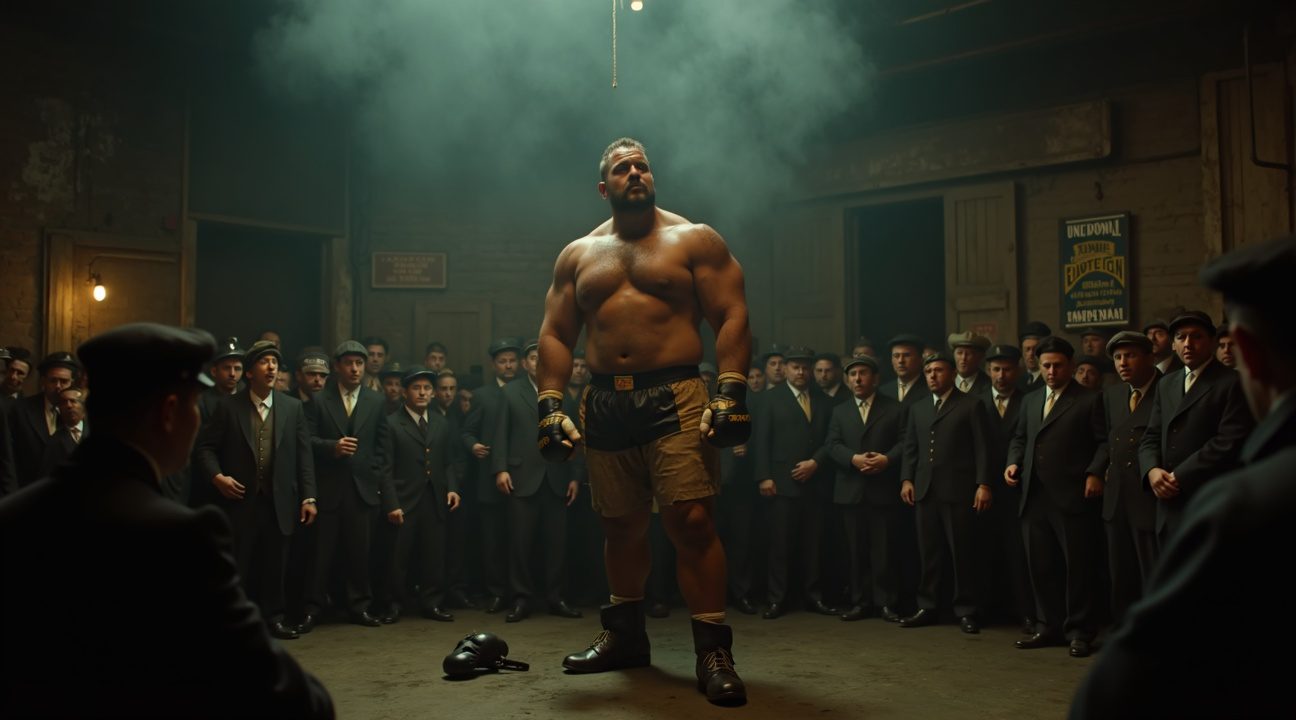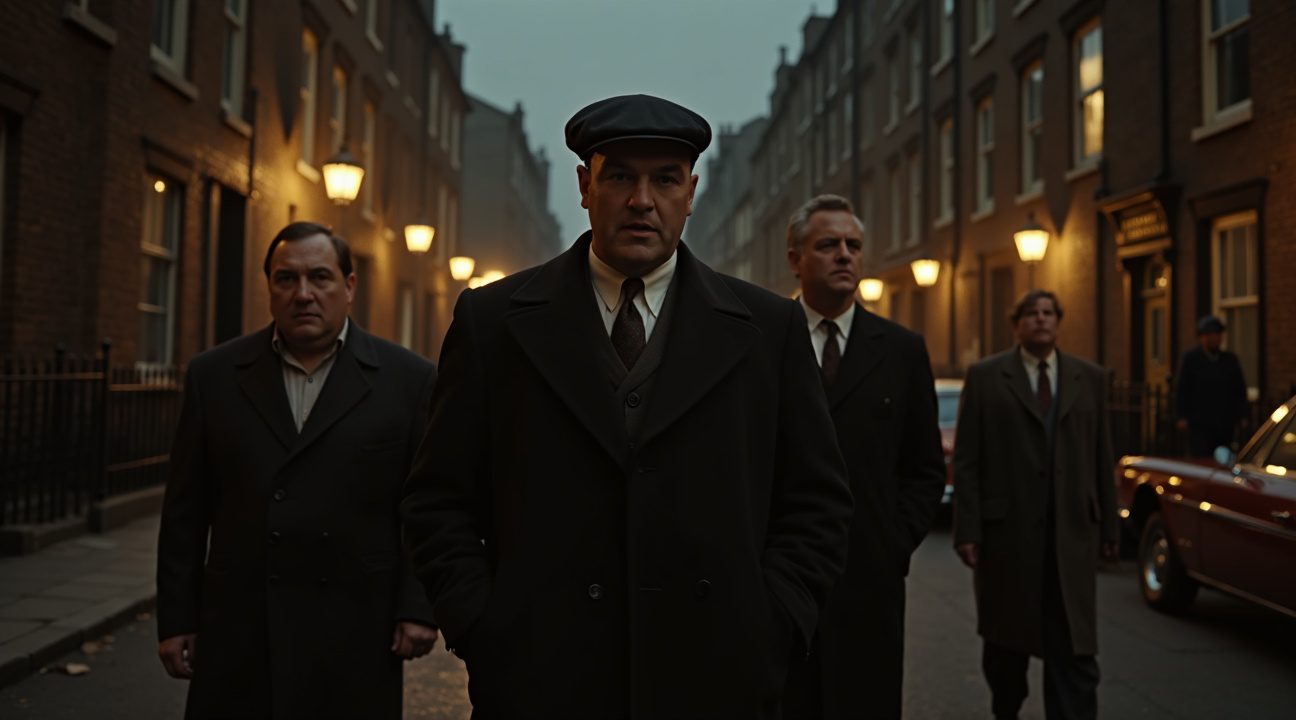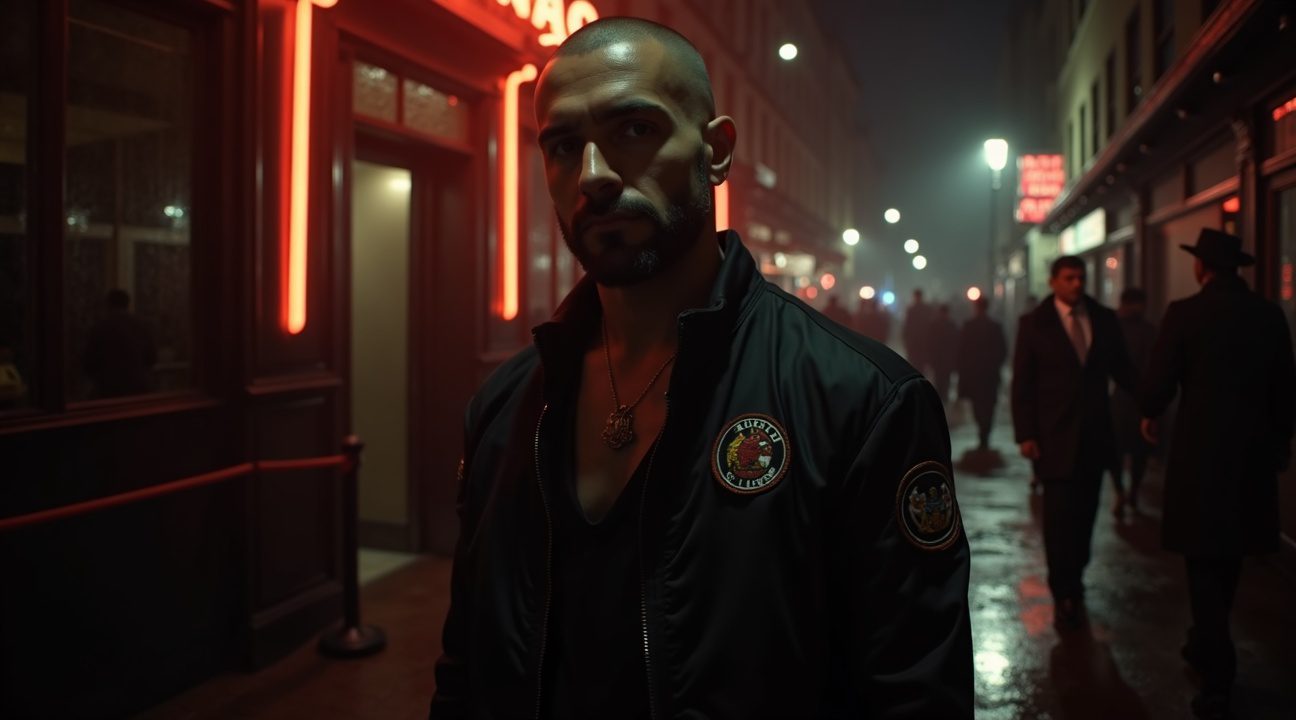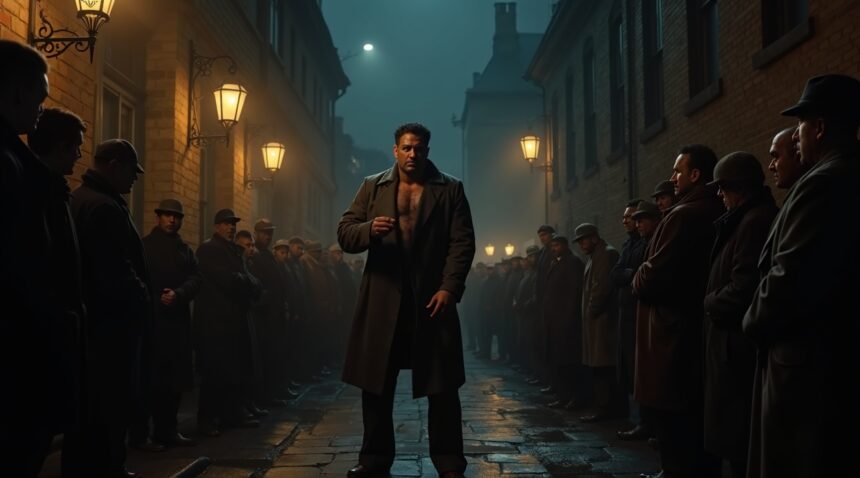Lenny McLean, known as “Britain’s Hardest Man,” carved out an extraordinary legacy through over 3,000 documented fights and close friendships with London’s most notorious criminals, including the infamous Kray twins. His journey from the brutal streets of East London’s Hoxton to Hollywood screens demonstrates how authentic toughness and street credibility could transcend traditional boundaries between organized crime, underground fighting, and mainstream entertainment.
Key Takeaways
- McLean claimed involvement in 2,000-3,000 unlicensed bareknuckle fights throughout his career, establishing a record that dwarfs most professional boxers who rarely exceed 100 matches in their entire careers.
- Standing 6’3″ and weighing over 20 stone, McLean dominated London’s underground fighting scene while maintaining genuine friendships with notorious criminals like Ronnie and Reggie Kray, Ronnie Biggs, and Charles Bronson.
- Despite his fearsome reputation, McLean suffered notable defeats against Cliff Fields, a 6’7″ opponent who beat him twice, proving that even Britain’s hardest man remained vulnerable against the right opponent.
- McLean successfully transitioned from nightclub enforcer and street fighter to Hollywood actor, landing the iconic role of Barry the Baptist in Guy Ritchie’s “Lock, Stock and Two Smoking Barrels”.
- His death from cancer in 1998 at age 49 came just months before his film debut, but his autobiography “The Guv’nor” became a bestseller and cemented his legacy as a cultural icon who bridged the gap between criminal underworld and mainstream entertainment.
From East End Streets to Britain’s Most Feared Fighter
Lenny McLean entered this world on April 9, 1949, in Hoxton, London, where the unforgiving streets would shape him into something extraordinary. Growing up in the East End of London meant surviving in an environment where toughness wasn’t optional—it was essential for daily existence.
The East End during McLean’s formative years was synonymous with its gritty criminal underworld and uncompromising street culture. This harsh landscape became McLean’s training ground, where he developed the raw fighting instincts that would eventually make him legendary. Unlike other notorious fighters, McLean’s reputation grew organically from the streets rather than through organized sporting channels.
The Making of ‘The Guv’nor’
McLean’s transformation from East End resident to Britain’s most feared fighter began in the late 1960s when he first earned the nickname ‘Britain’s Hardest Man.’ His reputation wasn’t built overnight—it developed through countless confrontations and challenges that tested his mettle against London’s toughest characters. The late 1980s marked the peak of his notoriety, cementing his status as an unstoppable force.
His formidable background as a hardman stemmed from more than just physical prowess. McLean possessed an intimidating presence that could settle disputes before they escalated into violence. This combination of psychological warfare and devastating fighting ability set him apart from other street fighters of his era. The criminal underworld respected him not just for his fists, but for his unwavering code of honor.
The moniker ‘The Guv’nor’ perfectly captured McLean’s position in London’s hierarchy of hard men. This title represented his undisputed authority in settling disputes and his role as the ultimate arbiter when violence became necessary. Unlike modern combat sports where fighters compete within structured environments, McLean operated in a world where reputation meant everything and losing could have dire consequences.
McLean’s East End origins provided him with invaluable street wisdom that formal training couldn’t replicate. He understood the psychology of intimidation, the importance of reputation, and how to read dangerous situations before they exploded. These skills, combined with his natural fighting ability, created a perfect storm that would eventually lead to over 3,000 documented fights throughout his career.
His rise from the streets of Hoxton to becoming Britain’s most recognized hardman demonstrates how authentic toughness transcends organized sport. While professional fighters like Tyson Fury dominate boxing rings, McLean’s domain was the unpredictable arena of street justice where rules didn’t exist and mercy was rarely shown.
The Staggering Fight Record That Made Him a Legend
Lenny McLean’s fighting career defied conventional boxing statistics in ways that seem almost impossible to comprehend. He claimed involvement in between 2,000 and 3,000 unlicensed, bareknuckle fights throughout his career, establishing a record that dwarfs even the most prolific professional fighters. This astronomical number placed him in a category entirely separate from sanctioned boxing, where athletes typically compete in far fewer matches over their entire careers.
Physical Dominance in Underground Boxing
Standing at 6 feet 3 inches (191 cm) and weighing over 20 stone (approximately 127-130 kg or 280 pounds), McLean possessed the physical attributes that made him a genuinely intimidating presence. His massive frame combined with raw power created a formidable opponent in the underground fighting scene. During his prime years, this combination of size and aggression earned him recognition as the ‘unofficial heavyweight champion of Great Britain’, a title that carried significant weight in unlicensed boxing circles.
The sheer scale of McLean’s claimed fighting record becomes even more remarkable when compared to professional boxing standards. Most professional boxers rarely exceed 100 matches throughout their entire careers, making McLean’s purported 2,000-3,000 fights an extraordinary testament to his involvement in underground combat sports. Britain’s hardest fighters often operated outside conventional sporting frameworks, but McLean’s numbers suggest an almost constant state of combat readiness.
The Underground Fighting Legacy
McLean’s fighting career highlighted the extraordinary scale of underground boxing culture that existed parallel to sanctioned professional sport. His claimed fight count wasn’t just about personal achievement; it represented decades of involvement in a subculture where disputes were settled with fists rather than words. The frequency of these encounters suggests McLean didn’t simply participate in occasional bareknuckle matches but lived within a community where physical confrontation was a regular occurrence.
The legitimacy of such high fight numbers continues to generate discussion among combat sports enthusiasts and historians. However, the consistency of these claims throughout McLean’s life, combined with numerous witness accounts from his era, suggests that even if the exact figure remains debatable, the scale of his fighting involvement was genuinely exceptional. His reputation wasn’t built on a handful of high-profile victories but rather on the accumulated weight of countless confrontations over many years.
This fighting frequency also demonstrates the different nature of unlicensed boxing compared to professional sport. While professional fighters might have months between matches for training and recovery, McLean’s world operated under different rules where fights could happen with little notice and minimal preparation time. The underground scene valued toughness and durability over technical refinement, qualities that McLean possessed in abundance.
McLean’s claimed record serves as a window into a bygone era of British working-class culture where physical prowess carried social currency. His 3,000 fights weren’t just personal achievements but represented his position within a community that valued strength and resilience above conventional success markers. This legacy continues to fascinate those interested in combat sports history, particularly the intersection between organized crime, working-class culture, and underground fighting that characterized mid-to-late 20th century Britain.
The numbers alone tell only part of McLean’s story, but they establish the foundation for understanding why his reputation extended far beyond typical sporting achievement into the broader cultural consciousness of his time.

Close Friends with London’s Most Notorious Gangsters
Lenny McLean’s reputation extended far beyond the boxing ring and bare-knuckle fighting circuit. His connections to London’s criminal underworld positioned him as a bridge between legitimate sport and organized crime during some of the capital’s most turbulent decades.
The Kray Connection
McLean developed particularly strong bonds with Ronnie and Reggie Kray, the twin brothers who dominated London’s East End during the 1960s and 1970s. These relationships weren’t merely professional associations—they represented genuine friendships forged through mutual respect and shared experiences in London’s unforgiving streets. The Krays recognized McLean’s fighting prowess and unwavering loyalty, qualities they valued highly in their circle of associates.
His friendship network extended to other notorious figures including Ronnie Biggs and Charles Bronson, individuals whose names became synonymous with violence and criminal notoriety. These connections weren’t accidental—McLean’s formidable physical presence and reputation for never backing down from confrontation made him a natural ally for those operating outside the law. I’ve observed that British fighting legends often found themselves caught between legitimate sporting careers and underground criminal activities.
McLean’s dual identity proved remarkably valuable throughout his career. Criminal associates respected his ability to handle himself in any situation, while legitimate businesspeople and entertainment figures appreciated his straightforward approach and protective instincts. This unique position allowed him to move seamlessly between different worlds without compromising his standing in either.
The fighter’s loyalty to his criminal friends never wavered, even as law enforcement increased pressure on organized crime networks. McLean understood the code of silence that governed these relationships and maintained his friendships despite the personal risks involved. His associations with figures like controversial personalities demonstrated his ability to separate personal loyalty from moral judgment.
These criminal connections also provided McLean with protection and opportunities that wouldn’t have been available through conventional channels. The respect he commanded among London’s most dangerous individuals meant potential threats were quickly neutralized, allowing him to focus on his fighting career without constantly looking over his shoulder.
McLean’s relationships with the Krays and other criminal figures reflected the complex social dynamics of post-war London, where traditional boundaries between legal and illegal enterprises often blurred. His ability to maintain friendships across these divides while building a legitimate career in entertainment showcased the unique character that made him both feared and beloved throughout his life.

From Construction Site Violence to Nightclub Enforcer
McLean’s reputation for violence began with an explosive incident that would change his life forever. While working on a construction site, he assaulted his boss in a fit of rage, an act that earned him an 18-month prison sentence. This early brush with the law didn’t deter him—instead, it served as a catalyst that pushed him deeper into London’s underground fighting scene.
Prison had hardened McLean even further, and upon his release, he found himself gravitating toward the capital’s vibrant nightlife industry. The 1980s London club scene was a perfect fit for someone with his intimidating presence and willingness to use violence when necessary. He quickly established himself as one of the most feared bouncers in the city, working at high-profile venues that attracted celebrities and wealthy clientele.
The Nightclub Circuit
McLean’s work as a nightclub enforcer placed him at the center of London’s entertainment district, where his reputation preceded him. Club owners specifically sought him out for his ability to handle difficult situations with swift, decisive action. His presence alone was often enough to deter troublemakers, but when physical intervention was required, McLean delivered with devastating effectiveness.
The celebrity-frequented clubs where he worked exposed him to a different side of London society. Stars, gangsters, and business moguls all crossed paths in these establishments, and McLean became a familiar face among them. His role wasn’t just about throwing out drunk patrons—he served as a protector for the venue’s most valuable customers and helped maintain the exclusive atmosphere these clubs cultivated.
This period of his life also connected him to organized crime figures, including his friendship with the notorious Kray twins. The nightclub scene provided a natural meeting ground for various underworld characters, and McLean’s growing reputation made him a valuable contact for those operating outside the law.
McLean’s transition into professional unlicensed boxing came through connections he made during this time. Frank Warren’s National Boxing Council events in 1970 offered him a legitimate platform to channel his fighting skills. These sanctioned matches allowed him to earn money from his natural talent while building the legend that would eventually earn him the title of Britain’s Hardest Man.
The combination of construction site toughness, prison experience, and nightclub enforcement work had shaped McLean into a formidable fighter. Each environment had tested different aspects of his character, ultimately preparing him for the thousands of fights that would define his legacy in British boxing history.

The Rare Defeats That Humbled Britain’s Hardest Man
Even legends face moments that test their reputation, and Lenny McLean’s career wasn’t without its humbling experiences. Despite his fearsome standing in the unlicensed boxing circuit, McLean encountered defeats that would become as legendary as his victories.
The Giant Who Brought Down a Legend
Cliff Fields presented McLean with his most significant challenge. Standing at an imposing 6 feet 7 inches tall, Fields possessed the physical advantages that could trouble even the most seasoned bare-knuckle fighter. The towering opponent didn’t just defeat McLean once – he accomplished this feat twice, creating ripples throughout the underground fighting community.
These encounters with Fields demonstrated several crucial aspects of unlicensed combat:
- Height and reach advantages could neutralize McLean’s typical aggressive style
- Technical skill combined with physical attributes posed serious threats
- Even the most dominant fighters faced opponents who matched their intensity
- Psychological warfare played as important a role as physical prowess
Fields’ victories over McLean didn’t diminish the Guv’nor’s reputation. Instead, they enhanced the mystique surrounding both fighters and the sport itself. The defeats showed McLean’s human side while simultaneously elevating the drama of their encounters. Each loss became a chapter in the broader narrative of Britain’s underground fighting scene, where British hardest man status could shift with a single well-placed punch.
McLean’s response to these setbacks revealed his true character. Rather than retreating from competition or making excuses, he continued fighting with the same intensity that had made him famous. The defeats served as fuel for his determination, proving that authentic toughness isn’t measured solely by an unbeaten record but by how one responds to adversity.
The folklore surrounding these rare losses actually strengthened McLean’s legend. Fight fans understood that anyone brave enough to step into the ring with McLean deserved respect, and those capable of defeating him earned mythical status themselves. Fields’ victories became talking points in pubs and gyms across Britain, with each retelling adding new layers to the story.
These defeats highlighted the unpredictable nature of unlicensed boxing, where reputations could be made or broken in minutes. McLean’s willingness to continue fighting despite these setbacks demonstrated the warrior mentality that defined his era. The losses reminded everyone that in the brutal arithmetic of bare-knuckle fighting, even the most feared competitors remained vulnerable to the right opponent on the right night.
From Gangster to Movie Star and Lasting Legacy
Lenny McLean’s transition from the underground fighting circuit to Hollywood screens represents one of the most remarkable reinventions in British popular culture. After decades of establishing his reputation as Britain’s hardest man, McLean set his sights on acting, demonstrating that his larger-than-life persona could captivate audiences beyond the bare-knuckle boxing world.
His breakthrough came when director Guy Ritchie cast him as Barry the Baptist in the crime caper “Lock, Stock and Two Smoking Barrels” in 1998. The role seemed tailor-made for McLean’s intimidating presence and authentic East London swagger. His performance as the debt collector who removes fingers with bolt cutters became instantly iconic, showcasing his natural charisma and screen presence. The casting wasn’t just about finding someone who looked tough – Ritchie needed an actor who embodied genuine menace, and McLean’s reputation preceded him.
A Tragic End and Posthumous Success
Fate dealt McLean a cruel hand when he passed away on July 28, 1998, at just 49 years old, mere months before “Lock, Stock and Two Smoking Barrels” hit cinemas. Cancer claimed the man who’d survived countless brutal encounters in unlicensed boxing rings and dangerous confrontations with London’s criminal underworld. His death robbed him of witnessing his transformation into a beloved pop culture figure, though his performance would cement his legacy far beyond the fighting community.
The film’s massive success turned McLean into a posthumous star. Audiences connected with his authentic portrayal of Barry the Baptist, recognizing something genuine in his performance that trained actors often struggle to achieve. His natural delivery and commanding screen presence made it clear that McLean possessed untapped acting potential that would sadly never be fully explored.
McLean’s lasting influence extends through multiple channels. His autobiography, “The Guv’nor”, became a bestseller and established the template for countless memoirs by former fighters and criminals. The book’s raw honesty about his brutal upbringing, violent career, and personal struggles resonated with readers who appreciated his unflinching self-examination.
Modern combat sports continue to reference McLean’s legacy. Fighters like Tom Hardy and high-profile boxers including Tyson Fury acknowledge the foundation McLean laid for fighters transitioning between different combat disciplines. Even contemporary boxing promotions, such as those featuring Jake Paul and Mike Tyson, draw inspiration from McLean’s ability to build compelling narratives around fighting personas.
The cult following surrounding McLean transcends typical celebrity worship. Fans appreciate his authenticity in an era increasingly dominated by manufactured personalities. His story represents genuine transformation – from a damaged child who found violence as his only outlet to a man who channeled his experiences into entertainment and literature.
Documentary filmmakers and biographers continue exploring McLean’s life, ensuring new generations discover his remarkable journey. His influence appears in everything from independent British films to major Hollywood productions that seek to capture the gritty authenticity he embodied.
McLean’s connection to the Kray twins adds another layer to his enduring fascination. His friendship with London’s most notorious criminals provides a direct link to a bygone era of British gangland culture that continues captivating public imagination.
Contemporary fighters and entertainers study McLean’s career trajectory, recognizing how he successfully monetized his reputation without compromising his core identity. His approach to self-promotion through storytelling and media appearances created a blueprint that many modern combat sports personalities follow.
The title “The Guv’nor” has become synonymous with McLean’s name, representing not just his fighting prowess but his ability to command respect across different spheres of British culture. His transformation from street fighter to movie star proves that compelling personalities can transcend their original environments when authenticity meets opportunity.
Sources:
Wikipedia – “Lenny McLean”
LADbible – “Britain’s Hardest Man Had Over 3000 Fights And Was Mates With The Krays”
LADbible – “Legendary Fighter ‘Iron Man’ Knocked Out Britain’s Hardest Man”
Kiddle – “Lenny McLean”


